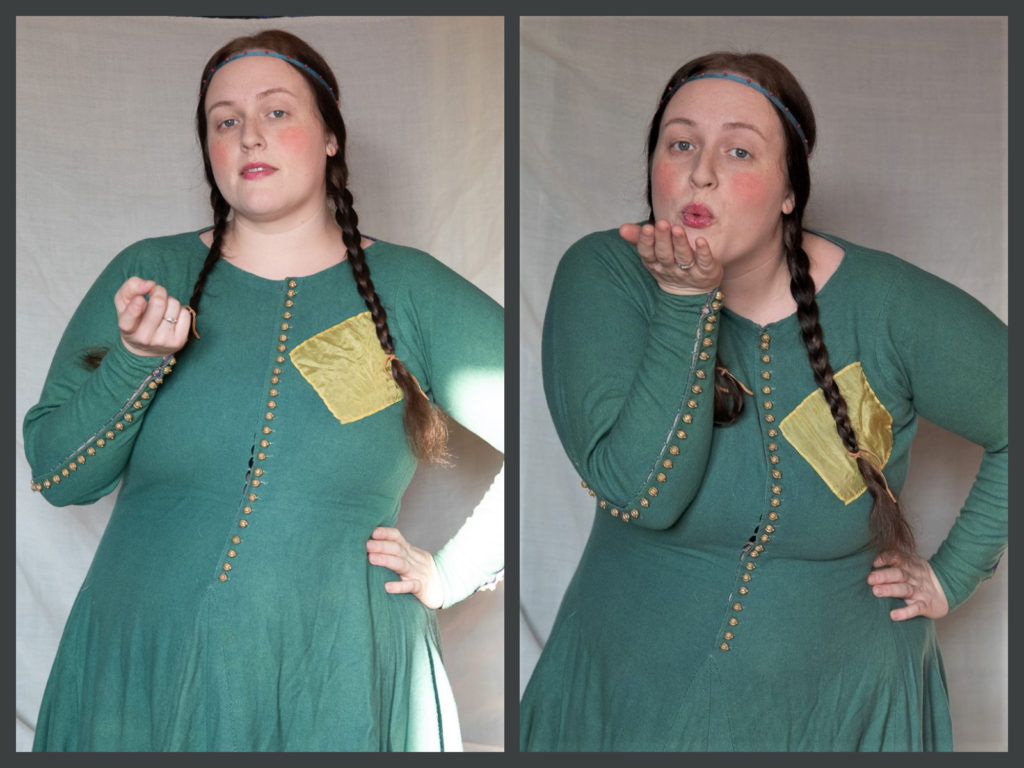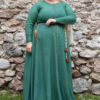The secret woman – A 14th century Viennese sexworker
Go on, this last one I still need to do for the #pluckingroses Challenge. :-D
Here is my impression of a “secret woman” from the second half of the 14th century.
I put a lot of different considerations into this photo and it seems like a good opportunity to show you all the work and research going into one costume that you might see at a high quality Living History event:
From sumptuary laws from Vienna and different middle European cities, we know that often sexworkers were explicitly forbidden to wear pelts and furs, silk and other expensive materials as well as fashionable items. These laws keep repeating the same point throughout the years, so it must have been fairly common for sexworkers to have some fashion statements going on and putting their spendings into outfits. Not only does this make sense as an investment into their attractivity, it also makes sense as an asset that contains the womans life savings in items that she can easily sell and that she takes with her all the time. Sexworkers were often organised in brothels and womens houses and probably did not exactly have a safe place to store their savings.
I chose my “good dress” with the silk edges. Fittingly, it is green, a colour that is in this time often associated with “vegetative”, animate, thriving forms of “love” (meaning the erotic or sexual aspects of love). This is reflected also in sumptuary laws ordering prostitutes to wear certain garments with green stripes or details. In Augsburg f.e., prostitues need to wear veils with green stripes.
Such a dress with a double dye and metal buttons would normally be the dress of at least a well-off crafter’s wife, but maybe it has aged, the hem is damaged, the colour is washed out, the cut is not up to the newest fashion any more, so its former owner sold it and bought a new one. Agnes however might have then bought it second hand in a year where business was good, which is still a considerable investment for her.
She also owns a silver ring and a silken filet with coral pearls on it. Rather small investments, but such that can easily be made into a quick buck if needed. A proper belt could also be such an item, we know that belts were in late medieval times considered an investment through all classes and an item that often landed in pounds when times were rough and something that was bought and rebought inherited and traded because of its handy format and value.
She is wearing her hair braided and does not wear a veil. Something that would be quite uncommon for a woman her age, but is often common practice for sexworkers. In some cities, sexworkers were forbidden to wear veils or at least certain forms of headcoverings, in some places it was even common for people who see known sexworkers wearing veils, to snatch them off their heads in the streets or openly accuse them of their “deceipt”. Sometimes even differences between “normal” people were openly escalated through such defamatory symbolic actions as snatching a headcovering off their opponent. After all, the veil was a sign of the honorable medieval woman and since a status in medieval society always came with certain priviledges, it was everyones duty to protect the godgiven order. Find more about hair and hairdos in the 14th century here.
Another characteristic attribute for a sexworker: She is wearing Makeup. We know from moral writers and written fiction of the time, that this practice was often understood as a practice of un-honorable women and sexworkers. (Textual sources on the practice of decorative cosmetics, german only). Find more on late medieval makeup in practice here and here.
The one item branding her as a sexworker however, is the yellow piece of cloth on her shoulder (the original text mentions “Achsel” which is meaning the whole shoulder and upper arm area). The Viennese sumptuary law of 1450 tells us it needs to be one hand long and wide and worn at the shoulder and I decided to sew it onto the dress so it is widely visible.
That a sexworker in 14th century Vienna would have worn this very symbol is however a shaky hypothesis of mine. Since the Viennese sumptuary law of 1380 is unfortunately lost and we only have some singular laws applying to dress left from this time frame, we are only left with the undated Viennese medieval sumptuary law which is only known to us through a copy from around 1450. The items mentionned in the law would also fit the fashion of the mid 1400s. We know that some laws and parts of laws have again and again been reconfirmed and copied over time, but wheither this applies to this sumptuary law, we unfortunately do not know.
To finish this article, one thing still needs to be said: A yellow dress is NOT necessarily the dress of a prostitute and a prostitute does NOT necessarily need to wear a yellow dress. Sumptuary laws are very different from town to town. Please dont sexually harrass other reenactors wearing yellow dresses. Thats not only asshole-y and potentially whorephobic but also based on a lack of knowledge about history.
Related Posts
The following posts might interest you as well:









